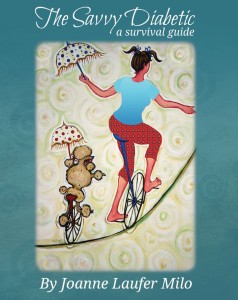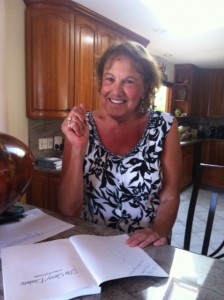The Savvy Diabetic – A Survival Guide
Joanne Laufer Milo was diagnosed with T1D over 49 years ago and she’s written about her amazing journey in a new book, The Savvy Diabetic: A Survival Guide. Joanne discusses this week with the TypeOneNation community her diagnosis, provides her advice on living with T1D, shares her involvement with JDRF and gives two things that are her best medicine to get through each day.
 My book, The Savvy Diabetic: A Survival Guide:
My book, The Savvy Diabetic: A Survival Guide:
This year is most exciting for me, as I’ve just published my first book called The Savvy Diabetic: A Survival Guide, which offers tips, tools, and techniques for diabetics to “survive” the medical system, travel, family life and simply coping. The idea for the book came out of my dreaded experiences as an unprepared patient in the hospital. I had always avoided being hospitalized, didn’t want to lose control or certainly didn’t want to let anyone else manage my diabetes. But the unexpected happened, hospitalizations not related to diabetes, and I had to figure out how to survive the hospital medical system. The first 2 hospitalizations scared me but I didn’t make changes until the third time, when I realized that I had better get prepared. And I wanted to share what I learned so that others might be better able to survive a hospital stay.
As I wrote, I interviewed diabetics about their experiences. And the opportunity to share these experiences along with the humorous quotes in the book, which allows us to smile despite the seriousness of the subject, are my most favorite part of writing.
I am blessed to have received amazing reviews from experts in the diabetes industry as well as well-known individuals in business and entertainment. Books can be purchased through my website (www.TheSavvyDiabetic.com) or directly at Amazon.com. The Kindle version is also available. I will donate 10% of net proceeds from my book sales to JDRF. And I am so inspired that I am working on two new project: a workbook/binder to keep medical information and notes from doctors’ appointment all organized and in one place; and another book, focused more specifically on coping with diabetes.
My diagnosis with type 1 diabetes:
I grew up on Long Island, New York. I had a fairly normally dysfunctional and loving family … until 2 weeks after my 11th, when I was diagnosed with diabetes (diabetes mellitus), in 1965. At that time, I had to use Clinitest (which I quickly learned I could cheat to get better readings ,not accurate but better numbers .Who was I fooling?) to check urine sugar and a Busher automatic injector to give myself injections.
I knew that this was a very serious disease. My mom cried a lot and my parents fought with each other, blaming my diagnosis on her side or his. The reality … the closest relative that I knew who had diabetes was a great-great grandfather, so getting diabetes was just “out of the blue!” My sister (2 years older) was very angry as I was getting a lot of attention, so she taunted me with food that I couldn’t have. Family life suddenly got way more stressful. Amidst the discussions about complications and a “blighted” life and a certain early death, my parents threw themselves into support and fundraising in the local diabetes community. There was no talk, at that time, about research or even a cure.
The hardest thing to deal with, living with diabetes:
Each decade has brought me unanticipated challenges. But I think the most difficult issue about life with diabetes is the constancy. It is truly 24/7, minute by minute. I NEVER get a vacation from it, it is ALWAYS there. I am constantly aware of how I’m feeling, what I’m eating, what activity I’m doing, I ding and buzz and alarm, I have to monitor supplies and dealing with pharmacies. It just doesn’t stop.
The second hardest thing about my life with diabetes: I’ve lost some very dear friends at way-to-early ages to the disease and its complications. That just hurts.
 Staying positive:
Staying positive:
I do stay mostly positive. I hate diabetes but I can recognize that having lived with the restraints and demands of managing diabetes has possibly made me choose healthier lifestyle options. I do get angry (like, when an infusion site isn’t working well or an alarm wakes me in the night). I resent the time I must spend, tending to all things diabetes (changing sites, changing sensors, testing blood glucose, calculating carbs, ordering and maintaining supplies and meds, seeing doctors and other health professionals, dealing with insurance, etc.). And I get tired. Tired of diabetes, tired of being vigilant, tired of concerns about complications and the future.
But I spend way more time living in gratitude, which helps. I know that we are living in the best possible time to be a person with diabetes. The technology helps. The medications are purer. And I just plain feel better being optimistic and trying to find the humorous aspects of all the interruptions and annoyances of diabetes. I’d much rather smile and laugh … it’s a choice that I make every day.
My Shooting Stars:
I started road biking in the early 1990’sand with a group of fellow bike riders (non-diabetics), I started a JDRF family walk team called the Shooting Stars, as I was “shooting” insulin. We started with 7 members (all of whom still walk or support our efforts every year) in 1997. By 2000, our team grew to over 60 walkers, and this has truly become a “family.” I start to get messages in mid-summer asking when we are walking again. I started to design our own team t-shirts in 1998 and have done so every year since then.
In 2007, I developed some foot complications and the official Walk site was not convenient. We decided to host our own Walk. And for 2 years, while I couldn’t walk, we did an “Un-Walk” Protest, at our home. People showed up with our team t-shirt, and “refused” to walk … a wildly successful fundraiser! Now, on the last Sunday of October, my husband Richard and I host a breakfast at a local coffee shop, free to anyone who shows up wearing our team t-shirt. We gather for an amazing team photo and then walk around Balboa Island, Newport Beach, to raise money as well as admire the wonderful Halloween decorations. This year was our 18th year with the Shooting Stars, raising over $8000 for JDRF.
Tightrope T1D:
This is a subcommittee with each JDRF chapter to reach out to adult T1Ds. As we are living longer and healthier, JDRF is recognizing the need to address this group. Depending on the local chapters and demographics, T1D holds informational programs and events and activities, to support T1s living with diabetes, their concerns and interests. It is another way to connect and learn and support the search for a cure.
Last words:
To date, I’ve had type 1 diabetes for 49 years, along with several associated autoimmune disorders. Despite all that, I’ve had a most varied life, lots of fun and interesting adventures. And I have always felt compelled to work with JDRF, in their efforts to cure diabetes. While I appreciate the newer JDRF goals to encompass improved technology for better living with diabetes, my personal goals remain steadily aimed at research for the cure.
It’s really important for diabetics to understand our own health issues and how we best manage. But we can also recognize that we do have core of shared experiences. We all deal with doctors, pharmacies, travel, families and simply trying to live our lives. Hearing others stories helps. Seeing humor in some of our stories, as well as the things people say, helps. Smiling and laughing truly are the best medicine for me.